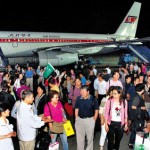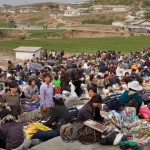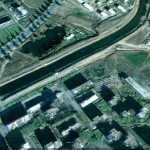Nicholas Eberstadt offers some stark economic data on the DPRK. According to his article:
While it is true that the DPRK suffered a severe economic shock from the collapse of the Soviet Bloc, this unexpected economic dislocation did not automatically presage log-term economic failure, much less famine. The counterexample of Vietnam–another socialist Asian economy heavily dependent on Soviet subsidies in the late 1980s–proves as much. According to the World Bank, Vietnam’s per capita income rose by over 150% between 1990 and 2007, and its per nominal per capita exports (in US dollars) rose by a factor of over 7 times during those same years, whereas North Korea’s nominal per capita exports slumped by over 25% between 1990 and 2007.
Further, it is of course true that the US–and in more recent years, Japan and South Korea–have imposed a plethora of economic sanctions on North Korea (America alone has over 30 such legal and administrative strictures in force today). But these penalties cannot explain North Korea’s miserable economic performance with the rest of the OECD countries, most of which are in principle open to commerce with the DPRK.
Let’s exclude Japan, South Korea, and America from OECD trade for the moment. Between 1980 and 2007, the import market for these other OECD countries expanded in nominal US dollars from just over $1 trillion to nearly $7 trillion–but according to the UN COMTRADE database, North Korea’s exports to those same countries collapsed: plummeting from $330 million to $177 million. When one takes inflation and population growth into account, this means the DPRK’s per capita exports to the rest of the OECD fell by almost 80% over those 27 years–and since these same export markets were growing all the while, North Korea’s share was twelve times smaller in 2007 than it had been in 1980.
What then is the problem? Closer inspection strongly suggests that North Korea’s long-term economic failure is directly related to the policies and practices embraced and championed by the Pyongyang government. North Korea’s current “own style of socialism” [or Urisik Sahoejuui] is a grotesquely deformed mutation of the initial DPRK command planning system, from which it fatefully and increasingly devolved over time.
North Korea is still in principle a planned Soviet-type economy: but for almost two decades it has in reality been engaged in “planning without facts”, and even in “planning without plans” (in the memorable phrase of Japanese economist Kimura Mitsuhiko). In and of itself, this would be enough to consign the North Korean economy to trouble. But to make matters worse, North Korean leadership has insisted on saddling the economy with a monstrous military burden under its campaign of “military-first politics” [Songun Chongchi]. Further, in contradistinction to virtually all other contemporary economies, North Korean trade policy for almost two generations has systematically throttled the import of productive and relatively inexpensive foreign machinery and equipment, thereby guaranteeing that the national economy would be saddled with a low-productivity, high-cost industrial infrastructure of its own making.
Add to this North Korea’s unrelenting war against its own consumers (no other modern economy has ever seen such a low ratio of consumer spending to national income, even at the height of Maoism or Stalinism) and Pyongyang’s stubborn, longstanding policy of “reverse comparative advantage” via a juche food policy that attempts to devote no more funds to overseas cereal purchases than foreigners pay for North Korean agricultural products in a country where cropland is scarce and growing seasons are short, and one begins to see how North Korean leadership engineered the country’s remarkable Great Leap Backward–and eventually, even a famine.
There is, to be sure, a grim logic to the DPRK’s destructive policies: for the same strategy that has ruined the country’s economy has also served to sustain its peculiar political system and ruling elite. In fact, given Pyongyang’s narrowly racialist ideology, its now-improbable but continuing quest for absolute mastery of the entire Korean peninsula and its undisguised fear that “ideological and cultural infiltration” will subvert the DPRK’s political order, the policies that the North Korean government pursues today may be regarded as careful, deliberate and faithful representations of the state’s overarching priorities.
Unfortunately, Pyongyang’s official policies and practices just happen to make the North Korean economy incapable of anything like genuine self-reliance, juche slogans notwithstanding, So DPRK state survival depends upon successfully generating a steady stream of subventions and concessional transfers from abroad.
Even so: the North Korean economy is so dysfunctional that it a positive net flow of foreign subsidies is not always enough to prevent calamity. After all: the Great North Korean Famine of the 1990s took place when the country (to judge by the import and export figures of its international trading partners) was receiving hundreds of millions of US dollars a year more in merchandise for abroad than it was shipping out. Quite obviously, that surplus was too small to overcome the grave built-in defects of the modern North Korean economy, or to forestall mass hunger.
So to continue its very existence, the North Korean system must commit itself to a permanent, predatory hunt for life-giving foreign funds: monies that it extracts from abroad by stratagems of military extortion, humanitarian hostage-negotiations (for the external feeding of its own population), and what might be called “guerilla commerce” (i.e., duping credulous foreigners who think there is money to be made from the DPRK by any but the country’s own elite).
North Korea, incidentally, seems to make it a point of honor not to repay its foreign creditors–and although “imperialist” banks and businesses from the West have learned this fact to their sorrow in abortive attempts to do commerce with Pyongyang, this is a bad habit that goes back to the early years of the Cold War, when the DPRK’s routinely reneged on loans from its “socialist comrades” in Beijing and Moscow.
North Korea has honed impressive skills in separating foreign governments from their own money. According to the US Congressional Research Service (CRS), for example, the USA transferred for than $1 billion in humanitarian, economic and security assistance to North Korea between 1995 and 2009: this despite a supposed “hostile US policy”. By the CRS’ reckoning, North Korea obtained over $4 billion from South Korea over those same years–and those were only the officially acknowledged payments by Seoul.
But China’s aid to North Korea puts all these Western subsidies in the shade. Beijing is almost completely opaque about its economic relations with Pyongyang–yet Chinese trade statistics suggest that North Korea has enjoyed a net resource transfer from China of over $9 billion since 1995, and the annual transfers look to have jumped markedly after 2004 (although China has never offered any sort of public explanation for why it would have increased its economic assistance to Pyongyang so significantly in recent years).
Earlier this year, North Korea announced a new “Ten Year State Strategy Plan for Economic Development” designed to lift the DPRK into the ranks of “the advanced countries by 2020”. Although the details of the plan have not yet been revealed, we can be sure it has enormous investment requirements–running into the tens or even hundreds of billions of dollars. It is also a safe bet that Kim Jong Il’s visit to China in May 2011 was a sort of fundraising tour aimed at securing some of the many billions of dollars envisioned by this ambitious plan.
After Kim Jong Il’s return from China, Pyongyang unveiled a new “joint economic zone” with China on two border islands in the Yalu rive–a projectr meant to underscore a new direction for the North Korean economy, and to jumpstart the new development campaign. But haven’t we seen this movie before? Ever since Kim Jong Il’s highly publicized visit to China in the early 1980s, there has been recurrent foreign speculation that would “inevitably” have to embrace economic reform. Yet all North Korean efforts at “opening” and “reform” to date have been confused and half-hearted, and every one of these initiatives has ultimately ended in failure.
Will this latest plan mark a decisive break from decades of ever more wayward North Korean economic policy? Some in China clearly believe that the DPRK can be gradually coaxed onto a path of pragmatic economic policymaking. To judge by Beijing’s swelling economic subsidies for North Korea, Chinese leadership may be banking on as much. The results of any such wagers, however, remain to be seen.
In China and other socialist countries, big changes in economic policy have typically followed, and depended upon, big changes in national leadership–but Pyongyang appears absolutely intent upon carrying the Kim family’s dynastic rule into its third generation. North Korean policymakers may genuinely want the DPRK to be what they call a “prosperous and powerful state” [Kangsong Taeguk]–but at the same time they have been totally unwilling to risk the sorts of steps that could actually generate such prosperity. Until this contradiction is resolved, North Korea is most likely to remain the black hole in the Northeast Asian economy.



